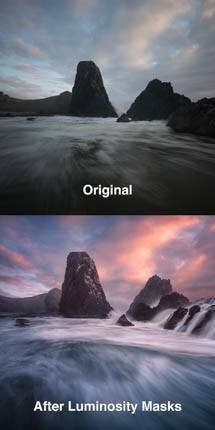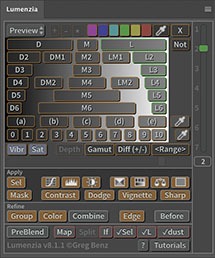My goal with Lumenzia is to make luminosity masking as easy as possible. To that end, I’ve tried to keep it streamlined, rather than add in a button for everything – especially for built in Photoshop tools that can be accessed with a shortcut or just a couple of clicks. But everyone’s needs are different. Not everyone has the time, experience, and inclination to memorize the wide array of Photoshop shortcut keys. And when you’re first learning luminosity masking, you might want some hints on other tools you should be using to get the job done. So, to help address these needs without adding a lot of clutter to Lumenzia itself, I’ve created a new panel that includes a wide range of functions useful for luminosity masking. I call this new panel “Lumenzia Basics” and it is included for free with Lumenzia. And just like Lumenzia, Basics supports Photoshop CS6 through the most recent version of CC, on both Mac and PC.
Lumenzia Basics includes:
- “Undo/Redo”: Click multiple times to go backwards / forwards multiple states.
- “Fill”: Content aware fill (if there is an active selection), or fill (if nothing is selected).
- “Stamp”: Stamp visible layers (ie, create a new layer that merges all layers)
- “SmartObj”: Convert selected layer(s) to a smart object. Or if a single smart object is selected, rasterize it.
- “X Mask”: Enable/disable selected layer’s mask.
- “Clip”: Create or release clipping mask for selected layer(s).
- “Invert”: Inverts active selection or selected layer’s mask. Prompts with options if both are available.
- “Deselect”: If there is no active selection, the last action selection will be re-selected.
- “Ants”: Show/hide marching ants for active selection.
- Layer blend modes and “Blend If”. Double-click a blend mode to return to normal blend mode (ie, if the layer is already in “overlay”, clicking overlay again will revert to normal.)
- Note that tooltips include descriptions of Photoshop shortcuts where available. This is a helpful way to learn shortcuts to further speed up your workflow in the future.
As a separate panel, Lumenzia Basics offers great flexibility to use these new tools however you want. For example, you can:
- Dock Basics on screen next to Lumenzia, so that all options are available immediately.
- Put Basics in a tab next to Lumenzia or minimize it to an icon, to keep it out of the way but easy to access when needed.
- Leave it closed or uninstalled if you don’t need it. Lumenzia and Basics are completely independent panels, so you can install just one of them if you prefer. The new install script will give you the option to install/uninstall either panel as you wish.

